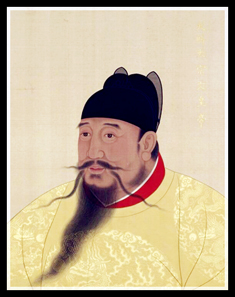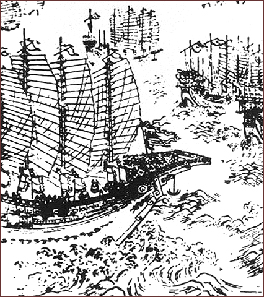April 25, 2013 – A joint expedition of scientists led by Chapurukha M. Kusimba of The Field Museum and Sloan R. Williams of the University of Illinois at Chicago has unearthed a 600-year-old Chinese coin on the Kenyan island of Manda. The coin proves that trade existed between China and east Africa decades before European explorers set sail and changed the map of the world.
Emperor Yongle (1360-1424) as depicted by a Palace Painter. Source: Wikipedia.
The coin, a small disk of copper and silver with a square hole in the center so it could be worn on a belt, is called “Yongle Tongbao” and was issued by Emperor Yongle who reigned from 1403-1425AD during the Ming Dynasty. The emperor’s name is written on the coin, making it easy to date. Emperor Yongle, who started construction of China’s Forbidden City, was interested in political and trade missions to the lands that ring the Indian Ocean and sent Admiral Zheng He, also known as Cheng Ho, to explore those shores.
Early 17th century Chinese woodblock print showing Zheng He s expedition vessels. Source: Wikipedia.
“Zheng He was, in many ways, the Christopher Columbus of China,” said Dr. Kusimba, Curator of African Anthropology at The Field Museum. “It’s wonderful to have a coin that may ultimately prove he came to Kenya,” he added.
Dr. Kusimba continued, “This finding is significant. We know Africa has always been connected to the rest of the world, but this coin opens a discussion about the relationship between China and Indian Ocean nations.”
That relationship stopped soon after Emperor Yongle’s death when later Chinese rulers banned foreign expeditions, allowing European explorers to dominate the Age of Discovery and expand their countries’ empires.
The island of Manda, off the northern coast of Kenya, was home to an advanced civilization from about 200AD to 1430AD, when it was abandoned and never inhabited again. Trade played an important role in the development of Manda, and this coin may show trade’s importance on the island dating back to much earlier than previously thought.
“We hope this and future expeditions to Manda will play a crucial role in showing how market-based exchange and urban-centered political economies arise and how they can be studied through biological, linguistic, and historical methodologies,” Dr. Kusimba said.
Other researchers who participated in the expedition to Manda include Dr. Janet Monge from the University of Pennsylvania, Mohammed Mchulla, staff scientist at Fort Jesus National Museums of Kenya and Dr. Amelia Hubbard from Wright State University. Also involved was Professor Tiequan Zhu of Sun Yat-Sen University, who identified the coin. The researchers also found human remains and other artifacts that predate the coin.
Currently the coin is being analysed in Chicago in order to secure that it is no counterfeit.
However, following this news readers of E-Sylum remarked that two years ago a Chinese/Kenyan team of archaeologists had unearthed a similar coin already. Apparently the Japanese once imitated the yongles adopting them as trade coins. So, instead of a Chinese expedition it could well have been Japanese traders to carry this coin with them to Africa. Additionally, one reader hints at cash-style coins that have been found in East Africa in the course of the last decades. So whether this finding is as spectacular as the Field Museum claims remains open.
Visit the very informative website of The Field Museum.
The comments on that topic are available on the E-Sylum website.






